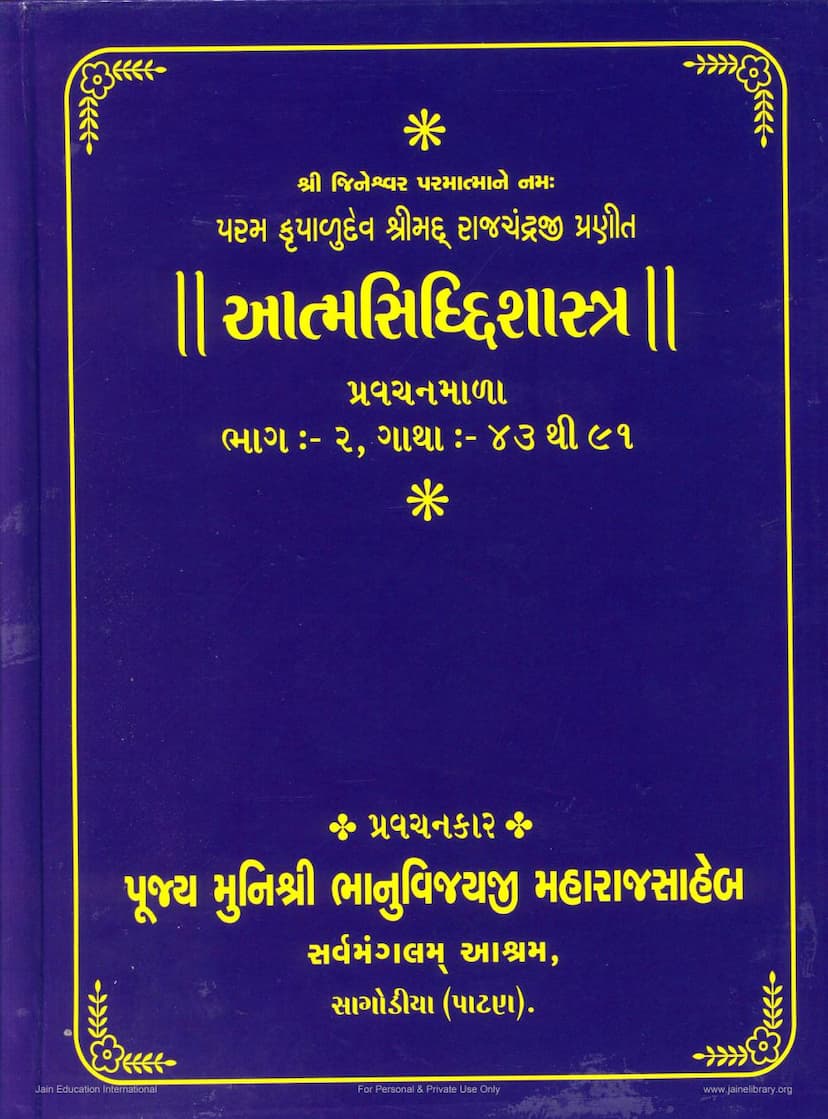Atmasiddhishastra Part 02
Added to library: September 1, 2025

Summary
Here's a comprehensive summary of the Jain text "Atmasiddhishastra Part 02," based on the provided pages:
This text is the second part of a discourse series on Shrimad Rajchandra's "Atmasiddhishastra," delivered by Pujya Munishri Bhanuvijayji Maharaj. The discourse covers verses 43 to 91 of the scripture. The aim of "Atmasiddhishastra" is the realization and accomplishment of the soul (Atma). Shrimad Rajchandra, in a guru-disciple dialogue format, elucidates the six fundamental aspects of the soul's truth, which helps to dispel false views and establish right views, ultimately leading to the destruction of worldly suffering and attainment of ultimate liberation (Moksha).
The text emphasizes the current societal condition where people are engrossed in material pursuits like wealth, status, and reputation, neglecting their humanity and pursuing selfish desires. Simultaneously, many mistake religious practice for mere external rituals, ceremonies, idol worship, and listening to scriptures, instead of seeking inner peace, equanimity, and true joy. In this context, the "Atmasiddhishastra" is presented as a valuable guide for spiritual seekers.
The discourse addresses the spiritual doubts, confusions, and illusions of earnest souls, offering clear and profound solutions through the wisdom of Shrimad Rajchandra and the explanations of Pujya Munishri Bhanuvijayji Maharaj. The ultimate goal is to enable disciples to confidently understand the soul's existence, permanence, agency, experience of actions, liberation, and the means to achieve it, leading to self-absorption and transcendental experience.
The compilation of these discourses is a significant effort, especially by Shrimati Bharatieben Niranjanbhai Mehta, who meticulously prepared the handwritten transcriptions of Pujya Guruji's talks. The text includes detailed explanations of each verse, clarifying its profound spiritual message and the soul-centric flow within the scripture. The commentary highlights Shrimad Rajchandra's characteristic qualities of impartiality, fairness, humility, selflessness, and, most importantly, his universal outlook and equal-mindedness towards all religions, stemming from his profound self-experience.
The book is structured as a dialogue where the disciple (Shishya) raises doubts (often representing common philosophical viewpoints of schools like Charvaka, Buddhism, and Sankhya) regarding the existence, eternality, agency, experience of karma, and the possibility of liberation. The Guru then provides clear, logical, and experiential solutions.
Key themes and concepts explored through the verses (43-91) include:
-
The Six Fundamental Truths of the Soul (Shadpad): The core of the discourse revolves around establishing the six essential truths about the soul:
- The Soul Exists: Addressing skepticism that denies the soul's existence due to its imperceptible nature.
- The Soul is Eternal: Countering the belief that the soul is impermanent and bound by the lifespan of the body or ephemeral states of consciousness.
- The Soul is the Doer of its Karma: Clarifying the soul's role in action, addressing arguments that karma is impersonal or caused by external forces.
- The Soul is the Experiencer of its Karma: Explaining how the soul experiences the consequences of its actions.
- Liberation (Moksha) Exists: Asserting the reality of liberation as a state of freedom from the cycle of birth and death.
- The Means to Liberation is Righteousness (Suddharma): Outlining the path and practices that lead to liberation.
-
Addressing Philosophical Objections: The text systematically presents and refutes various philosophical viewpoints (often attributed to schools like Charvaka, Buddhism, Sankhya, and Mimamsa) that deny or misunderstand these fundamental truths. The Guru addresses the disciple's doubts, which are framed as common skeptical arguments from these traditions.
-
The Importance of Discrimination and Realization: The discourses emphasize the need for deep contemplation, logical reasoning, and ultimately, direct self-experience to overcome doubts and grasp the true nature of the soul.
-
The Role of the Guru: The dialogue format highlights the crucial role of a living Guru in guiding the disciple through their spiritual journey, clearing doubts, and providing the necessary impetus for self-realization.
-
The Nature of Reality: The text delves into the distinction between the soul (Jiva, Cetana) and non-soul (Ajiva, Pudgala, Jad) entities, explaining their independent existence and interaction through karma.
-
The Path to Liberation: The ultimate aim is to achieve Moksha, which is described not as a destination but as the realization of one's true, pure, and liberated soul-nature, free from the bondage of karma and worldly afflictions.
The discourses are presented in a clear, accessible, and devotional style, aiming to uplift the seeker towards the ultimate truth of the soul's nature and the path to its liberation. The publication is dedicated to the spiritual lineage and the revered Guru, highlighting the importance of tradition and guidance in spiritual progress. The text encourages readers to delve deeply into these teachings for their own spiritual welfare and ultimate liberation.